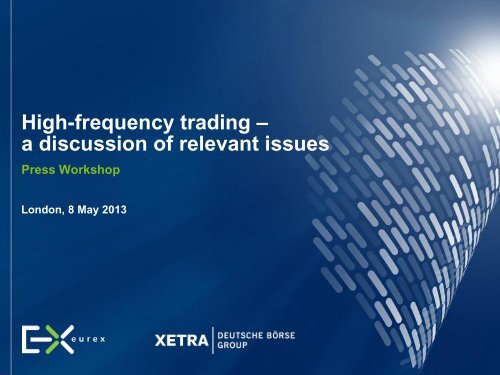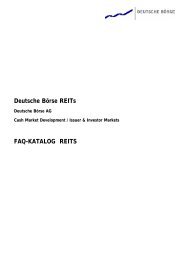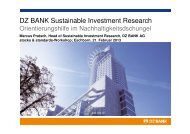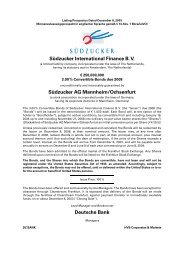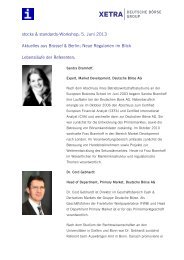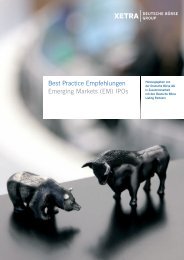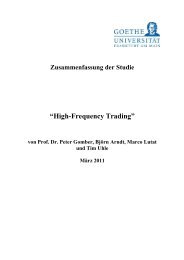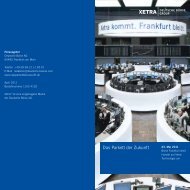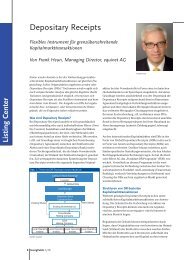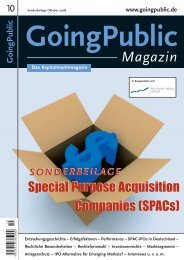High-frequency trading – a discussion of relevant issues - Xetra
High-frequency trading – a discussion of relevant issues - Xetra
High-frequency trading – a discussion of relevant issues - Xetra
- No tags were found...
Create successful ePaper yourself
Turn your PDF publications into a flip-book with our unique Google optimized e-Paper software.
<strong>High</strong>-<strong>frequency</strong> <strong>trading</strong> <strong>–</strong>a <strong>discussion</strong> <strong>of</strong> <strong>relevant</strong> <strong>issues</strong>Press WorkshopLondon, 8 May 2013
<strong>High</strong>-<strong>frequency</strong> <strong>trading</strong> <strong>–</strong> a <strong>discussion</strong> <strong>of</strong> <strong>relevant</strong> <strong>issues</strong> May 2013AgendaHFT <strong>–</strong> background• How do you define high-<strong>frequency</strong> <strong>trading</strong> (HFT)?• What are the most common HFT strategies?• Why is the speed so important?• What is the impact <strong>of</strong> HFT on market quality?HFT <strong>–</strong> <strong>issues</strong>• Do HFT users cause volatility?• Why are there critical voices on HFT from institutional investors?• How do HFT firms (re-)act in critical times?HFT <strong>–</strong> Regulation• How do regulators deal with HFTs?• What impact does the German HFT Bill have for HFTs?2
<strong>High</strong>-<strong>frequency</strong> <strong>trading</strong> <strong>–</strong> a <strong>discussion</strong> <strong>of</strong> <strong>relevant</strong> <strong>issues</strong> May 2013Differentiation <strong>of</strong> “algorithmic <strong>trading</strong>” (AT) and HFTCommon factors <strong>of</strong> AT and HFT:• Pre-designed <strong>trading</strong> decisions• Used by pr<strong>of</strong>essional traders• Observing market data in real-time• Automated order submission, automated order management• No human intervention• Use <strong>of</strong> direct market accessTypical characteristics <strong>of</strong> AT excl. HFT• Primary agent <strong>trading</strong>• Minimize market impact (for large orders)• Significant positions overnight• Typical holding periods: days/weeks/months• Working an order through time and across marketsTypical characteristics <strong>of</strong> HFT• Proprietary <strong>trading</strong>• <strong>High</strong> number <strong>of</strong> orders, rapid order cancellation• Mainly spread and arbitrage income• No significant position at the end <strong>of</strong> a day (flat position)• Short holding periods, small margin per trade• Low latency requirement• Focus on highly liquid instrumentsSource: Gomber et al. (2011)3
<strong>High</strong>-<strong>frequency</strong> <strong>trading</strong> <strong>–</strong> a <strong>discussion</strong> <strong>of</strong> <strong>relevant</strong> <strong>issues</strong> May 2013HFT is a technology applied to a broad spectrum <strong>of</strong> strategiesA conclusive definition <strong>of</strong> HFT is difficult since it is the technology necessary for implementing a broadrange <strong>of</strong> latency sensitive strategies.HFT is a technology, not astrategyLimited commondenominator <strong>of</strong> HFT-basedstrategiesDifferent perceptions in theindustry• HFT uses a wide range <strong>of</strong>strategies with very differentcharacteristics.• HFT is an advancedimplementation <strong>of</strong> pre-existingstrategies.• HFT-based strategies only haveone thing in common, the need tobe competitively fast in order toaddress pr<strong>of</strong>it opportunities and,more importantly, avoid beingtaken advantage <strong>of</strong> by others, i.e.avoid losses.• Everyone in the financial industryhas an individual idea <strong>of</strong> whatHFT is.• The opinions on HFT varyconsiderably depending on whatthe observer considers a typicalHFT strategy.• The majority <strong>of</strong> Eurex Exchange’soptions Market Makers do notconsider themselves HFT, whilethey would fulfill the existingdefinition <strong>of</strong> HFT.4
<strong>High</strong>-<strong>frequency</strong> <strong>trading</strong> <strong>–</strong> a <strong>discussion</strong> <strong>of</strong> <strong>relevant</strong> <strong>issues</strong> May 2013HFT is a natural evolution <strong>of</strong> financial markets based on technologicalprogress and competition• The term HFT was coined in approximately 2006.• However, there was no binary event at which HFT strategies/firms entered the market.• Speed has always been an essential factor for success in exchange <strong>trading</strong>, e.g. the pneumatic tube system <strong>of</strong> NYSE (1903).• The importance <strong>of</strong> speed in electronic markets has dramaticallyincreased.• On Eurex Exchange, since its foundation in the 90s, market makerscompeted fiercely on speed. It used to be about 1/10-seconds and nowit is 1/1000-seconds.• Latency is a necessary condition for theimplementation <strong>of</strong> various types <strong>of</strong> strategies,but advantages <strong>of</strong> latency are no longersufficient for the success.1990s 2000s FutureDuring the first years <strong>of</strong> the new century, the importance <strong>of</strong> latency in the industry increased enormously. Reasons include:• All <strong>relevant</strong> exchanges have introduced electronic <strong>trading</strong>.• Latency became a dimension <strong>of</strong> exchange competition.• Exchanges started to serve latency sensitive <strong>trading</strong> strategies, e.g. proximity service, co-location service, connectivityoptions.• Increasing interconnection between exchanges through electronic algorithms (best execution order routing).• Increased use <strong>of</strong> algorithm for execution <strong>of</strong> non-latency sensitive orders through institutional investors.• Nevertheless, the transition <strong>of</strong> existing markets occurred rather slowly.• At Eurex Exchange, the replacement <strong>of</strong> futures tick traders by computer driven algorithms essentially implementing thesame strategy, took years.• During the same time, the Eurex Exchange options market became faster, but the fundamental options market structuredid not change.5
<strong>High</strong>-<strong>frequency</strong> <strong>trading</strong> <strong>–</strong> a <strong>discussion</strong> <strong>of</strong> <strong>relevant</strong> <strong>issues</strong> May 2013AgendaHFT <strong>–</strong> background• How do you define high-<strong>frequency</strong> <strong>trading</strong> (HFT)?• What are the most common HFT strategies?• Why is the speed so important?• What is the impact <strong>of</strong> HFT on market quality?HFT <strong>–</strong> <strong>issues</strong>• Do HFT users cause volatility?• Why are there critical voices on HFT from institutional investors?• How do HFT firms (re-)act in critical times?HFT <strong>–</strong> Regulation• How do regulators deal with HFTs?• What impact does the German HFT Bill have for HFTs?6
<strong>High</strong>-<strong>frequency</strong> <strong>trading</strong> <strong>–</strong> a <strong>discussion</strong> <strong>of</strong> <strong>relevant</strong> <strong>issues</strong> May 2013The majority <strong>of</strong> HFT- based strategies belong to two types: Liquidityprovision and arbitrage*Liquidity provision• The majority <strong>of</strong> HFT-based strategies are liquidity provision strategies, as every form <strong>of</strong> liquidity provision in electronicmarkets requires extremely fast response times.• The reason is all provided bids and <strong>of</strong>fers are based on certain sets <strong>of</strong> information.• When information changes, this implies different prices, bids and <strong>of</strong>fers.• Accordingly, liquidity providers need to be as fast as possible in: a) receiving the new information, b) transforming thenew information into new prices, bids/<strong>of</strong>fers and c) update the bids/<strong>of</strong>fers provided to the exchange.• The faster the liquidity provider can act, the lower the risk <strong>of</strong> liquidity provision and the higher the quality <strong>of</strong> providedquotes.• Primary source <strong>of</strong> income: Spread.(Statistical) arbitrage• Take advantage <strong>of</strong> price differences (market inefficiencies) between economically identical or similar products.• Actors calculate fair product values/spreads, and in case <strong>of</strong> any deviations, they sell the more expensive product, andbuy the cheaper product.• This way, unjustified price differences between economically related products are eliminated.• Arbitrage assures clients fair pricing across all markets/products and thereby reduces their information costs infragmented markets.• Primary source <strong>of</strong> income: Short term market inefficiency.* Hagströmer, Nordén (2012) found that 63 - 72 % <strong>of</strong> HFT <strong>trading</strong> volume is provided by liquidity provision strategies .7
<strong>High</strong>-<strong>frequency</strong> <strong>trading</strong> <strong>–</strong> a <strong>discussion</strong> <strong>of</strong> <strong>relevant</strong> <strong>issues</strong> May 2013These other two strategy types exist as long as markets existShort term momentum-strategy• New information leads to new price levels.• These strategies attempt to generate pr<strong>of</strong>its by reacting swiftly to new information.• As a result, new information is reflected in the market prices extremely quickly.• Besides new information, market moves can generate <strong>trading</strong> signals (“riding the short term trend”).• Primary source <strong>of</strong> income: Short term shift in general price level.Liquidity detection-strategy• Detection <strong>of</strong> hidden orders or orders that are generated by execution algorithms.• The aim is to gather information about the direction <strong>of</strong> the customer flow and thus the market prices.• Often used by electronic liquidity providers in order to recognize the market direction at an early stage.• Primary source <strong>of</strong> income: To take advantage <strong>of</strong> short term trends or avoidance <strong>of</strong> losses when providingliquidity.8
<strong>High</strong>-<strong>frequency</strong> <strong>trading</strong> <strong>–</strong> a <strong>discussion</strong> <strong>of</strong> <strong>relevant</strong> <strong>issues</strong> May 2013AgendaHFT <strong>–</strong> background• How do you define high-<strong>frequency</strong> <strong>trading</strong> (HFT)?• What are the most common HFT strategies?• Why is the speed so important?• What is the impact <strong>of</strong> HFT on market quality?HFT <strong>–</strong> <strong>issues</strong>• Do HFT users cause volatility?• Why are there critical voices on HFT from institutional investors?• How do HFT firms (re-)act in critical times?HFT <strong>–</strong> Regulation• How do regulators deal with HFTs?• What impact does the German HFT Bill have for HFTs?9
ALVEONDTEBASSIESAPDAIBAYALVEONDTEBASSIESAPDAIBAY<strong>High</strong>-<strong>frequency</strong> <strong>trading</strong> <strong>–</strong> a <strong>discussion</strong> <strong>of</strong> <strong>relevant</strong> <strong>issues</strong> May 2013Speed is a risk management tool for participantsA Market Maker’s quote…• …is valid until cancelled.• …needs to be updated when theinformation changes.• …results in exposure/risk for the timeuntil the existing quote is either updatedor cancelled at the exchange.XLM (bp) <strong>–</strong> order size €1MN140120100806040200Oct-01Aug-11The higher the speed…• …the more immediate the transfer <strong>of</strong> risk.• …the more liquidity the Market Maker isprepared to <strong>of</strong>fer.• …the tighter the bid-ask spread the MarketMaker is willing to quote.XLM (bp) <strong>–</strong> order size €2MN250200150100500Oct-01Aug-11Reduction infrictionalcoststo end-users10
<strong>High</strong>-<strong>frequency</strong> <strong>trading</strong> <strong>–</strong> a <strong>discussion</strong> <strong>of</strong> <strong>relevant</strong> <strong>issues</strong> May 2013Reduction in exchange latency improves situation <strong>of</strong> liquidityproviders which leads to better market qualityThe biggest risk for liquidityproviders is that new informationimplies new price levels and theliquidity provider is not able toupdate its quotes before otherstake advantage <strong>of</strong> the outdatedquote.The indicator for this is thenumber <strong>of</strong> "unwanted trades":We measure it by the number <strong>of</strong>times, when one party sought tomodify/delete its order/quote, butit is was already matched.Evidence from Eurex Exchangeshows that a significant reductionin exchange latency in 2009 haslead to a massive reduction <strong>of</strong> thenumber <strong>of</strong> unwanted trades.This enables the liquidityproviders to provide higher quotequality in terms <strong>of</strong> spread andsize to the market.11
<strong>High</strong>-<strong>frequency</strong> <strong>trading</strong> <strong>–</strong> a <strong>discussion</strong> <strong>of</strong> <strong>relevant</strong> <strong>issues</strong> May 2013AgendaHFT <strong>–</strong> background• How do you define high-<strong>frequency</strong> <strong>trading</strong> (HFT)?• What are the most common HFT strategies?• Why is the speed so important?• What is the impact <strong>of</strong> HFT on market quality?HFT <strong>–</strong> <strong>issues</strong>• Do HFT users cause volatility?• Why are there critical voices on HFT from institutional investors?• How do HFT firms (re-)act in critical times?HFT <strong>–</strong> Regulation• How do regulators deal with HFTs?• What impact does the German HFT Bill have for HFTs?12
<strong>High</strong>-<strong>frequency</strong> <strong>trading</strong> <strong>–</strong> a <strong>discussion</strong> <strong>of</strong> <strong>relevant</strong> <strong>issues</strong> May 2013Explicit transaction costs decreased substantially for Europeaninstitutional investors through technical advancement ….• The share <strong>of</strong> high touch order execution decreased drastically in the last few years through theincrease in the availability technology. At the same time, the cost <strong>of</strong> high touch executions wascut in half.• No touch (DMA) occurs at very low cost and accounts now for approximately 80% <strong>of</strong> totalexecution.Method <strong>of</strong> execution20002005 2011% trades fee (bps) % trades fee (bps) % trades fee (bps)<strong>High</strong> touch touch 100% 25-40 70% 15-20 20% 10-15No No touch (DMA) (DMA) N.A. 30% 7-8 80% 1-3Source: IMC estimation13
<strong>High</strong>-<strong>frequency</strong> <strong>trading</strong> <strong>–</strong> a <strong>discussion</strong> <strong>of</strong> <strong>relevant</strong> <strong>issues</strong> May 2013… part <strong>of</strong> the reduced cost results from decreasing marketinfrastructure fees• Reduction in the costs <strong>of</strong> <strong>trading</strong>in all major financial centers(weighted average decrease <strong>of</strong>21%).• The cost <strong>of</strong> <strong>trading</strong> correspondsto the sum <strong>of</strong> fees charged by:<strong>–</strong> Trading platforms<strong>–</strong> Central counter-parties(CCP’s)<strong>–</strong> Central SecuritiesDepositories (CSD’s)Source: Monitoring prices, costs and volumes <strong>of</strong> <strong>trading</strong> and post-<strong>trading</strong> services by Oxera, May 2011.14
Basis points<strong>High</strong>-<strong>frequency</strong> <strong>trading</strong> <strong>–</strong> a <strong>discussion</strong> <strong>of</strong> <strong>relevant</strong> <strong>issues</strong> May 2013Liquidity varies over time, largely dependent on economic uncertaintyEurex Liquidity Measure (ELM)The ELM measures the round trip market impact cost <strong>of</strong>somebody executing a EUR 10 million market order onexchange.It is a proxy for liquidity. The smaller the price impact,the higher the liquidity.Visible liquidity decreasedLiquidity did not revert back to its high <strong>of</strong> Q2 2007.252010000000 - Avg. Advanced Price Movementin BPAt times <strong>of</strong> crisis, the market impact cost increases, asparticipants scale down their risk pr<strong>of</strong>ile, resulting inwider spreads and reduced sizes.In general, the liquidity readily available in the orderbook looks slightly worse in Q3 2012 than in 2005.One <strong>of</strong> the key contributors to this trend is the use <strong>of</strong>execution algo by the buy-side, which has vastlyreduced the placement <strong>of</strong> resting orders by the buy-sidein the transparent order book.HFT adds significant liquidity, but their order sizes aretypically much smaller.1510501 2 3 4 1 2 3 4 1 2 3 4 1 2 3 4 1 2 3 4 1 2 3 4 1 2 3 4 1 2 32005 2006 2007 2008 2009 2010 2011 2012Avg. Quarters15
020406080100120140Spread wideningtradePrice<strong>High</strong>-<strong>frequency</strong> <strong>trading</strong> <strong>–</strong> a <strong>discussion</strong> <strong>of</strong> <strong>relevant</strong> <strong>issues</strong> May 2013… however, the market has become much more resilientHow to quantify liquidity resilience?Fierce competition in liquidity provision strategies, usingHFT technology, increased the resilience <strong>of</strong> liquidity inour benchmark futures.How to quantify liquidity resilience?We focus on the recovery period after a big trade (in the case below; abuy) widened the spread.The top chart shows a stylized example <strong>of</strong> the spreadrecovery following a large aggressive order.The time it takes the liquidity to recover is a function <strong>of</strong>(a) volatility (b) order size and (c) competition forliquidity provision.By accounting for (a) and (b) it should be possible to saysomething about (c). The bottom graph shows averagerecovery paths for eight similarly volatile days; four from2010 and four from 2012.Evidence <strong>of</strong> resilience improvementCompared to 2010, the liquidity in the DAX futures became much moreresilient. The averages converge around 500ms from the big trade.60%askbidTimeaverage 2010We see a tremendous increase in resiliency comparedto 2010, implying increased competition for liquidityprovision.We argue that the increase in resiliency makes up for(part <strong>of</strong>) the reduction in visible liquidity.40%20%0%average 2012Time since big trade (in ms)16
<strong>High</strong>-<strong>frequency</strong> <strong>trading</strong> <strong>–</strong> a <strong>discussion</strong> <strong>of</strong> <strong>relevant</strong> <strong>issues</strong> May 2013AgendaHFT <strong>–</strong> background• How do you define high-<strong>frequency</strong> <strong>trading</strong> (HFT)?• What are the most common HFT strategies?• Why is the speed so important?• What is the impact <strong>of</strong> HFT on market quality?HFT <strong>–</strong> <strong>issues</strong>• Do HFT users cause volatility?• Why are there critical voices on HFT from institutional investors?• How do HFT firms (re-)act in critical times?HFT <strong>–</strong> Regulation• How do regulators deal with HFTs?• What impact does the German HFT Bill have for HFTs?17
<strong>High</strong>-<strong>frequency</strong> <strong>trading</strong> <strong>–</strong> a <strong>discussion</strong> <strong>of</strong> <strong>relevant</strong> <strong>issues</strong> May 2013What does volatility mean and what does it cause?Volatility is a measure <strong>of</strong> price variation <strong>of</strong> an instrument.It reflects the uncertainty about the future price <strong>of</strong> an asset or the market as a whole.It is amplified by the breadth <strong>of</strong> possible outcomes.Possible outcomesInflationGrowthFiscal consolidationStrengthening the EUR by reformsDeflationRecessionSovereign defaultBreakdown <strong>of</strong> the EUR18
<strong>High</strong>-<strong>frequency</strong> <strong>trading</strong> <strong>–</strong> a <strong>discussion</strong> <strong>of</strong> <strong>relevant</strong> <strong>issues</strong> May 2013HFT strategies typically benefit from volatility, but do not increase it• HFT strategies are intraday strategies.• Mean reversion is the basic strategy <strong>of</strong> most liquidity providers/Market Makers.19
<strong>High</strong>-<strong>frequency</strong> <strong>trading</strong> <strong>–</strong> a <strong>discussion</strong> <strong>of</strong> <strong>relevant</strong> <strong>issues</strong> May 2013What does research say?HFT dampens volatility• Credit Suisse (2010)• CME Group (2010)• Brogaard (2011)• Castura, Litzenberger, Gorelick,Dwivedi (2009)• Hasbrouck and Saar (2011)• Hagströmer, Nordén (2012)HFT has no effect on volatility• Chaboud, Chiquoine, Hjalmarssonand Vega (2009)• Frino, Lepone, Mistry (2010)• Hendershott and Riordan (2009)• UK Treasury Foresight Committee(2011)• Groth (2010)• Bank <strong>of</strong> international Settlements(2011)• Jarnecic, Snape (2010)HFT causes volatility• Zhang (2010)• Boehmer (2011)20
<strong>High</strong>-<strong>frequency</strong> <strong>trading</strong> <strong>–</strong> a <strong>discussion</strong> <strong>of</strong> <strong>relevant</strong> <strong>issues</strong> May 2013AgendaHFT <strong>–</strong> background• How do you define high-<strong>frequency</strong> <strong>trading</strong> (HFT)?• What are the most common HFT strategies?• Why is the speed so important?• What is the impact <strong>of</strong> HFT on market quality?HFT <strong>–</strong> <strong>issues</strong>• Do HFT users cause volatility?• Why are there critical voices on HFT from institutional investors?• How do HFT firms (re-)act in critical times?HFT <strong>–</strong> Regulation• How do regulators deal with HFTs?• What impact does the German HFT Bill have for HFTs?21
<strong>High</strong>-<strong>frequency</strong> <strong>trading</strong> <strong>–</strong> a <strong>discussion</strong> <strong>of</strong> <strong>relevant</strong> <strong>issues</strong> May 2013The accusation <strong>of</strong> front running is misleading and false• In public <strong>discussion</strong>s, the accusation is that, from time to time, HFT firms pursue front running <strong>of</strong>customer flow• This accusation is wrong. By definition, they are not able to pursue front running: they do not havecustomer flow and therefore, no private order flow information that they could abuse.If the accusation <strong>of</strong> front running is incorrect, where does it come from?• Usually, institutional investors have large orders, which they execute with the help <strong>of</strong> algorithms over time to minimizethe market impact (implicit transaction cost).• In contrast, numerous HFT firms are liquidity providers.• The greatest threat to a liquidity provider is that one or several large orders move the market. This created losses forthe liquidity provider, as they are the first counterparts to the large order and thereafter the market moves againstthem due to the large order size.• To compete successfully in the market, liquidity providers need to identify, as quickly as possible, when the marketmoves in a certain direction through large orders (usually generated by institutional customers).• Liquidity providers may witness price changing orders through liquidity detection strategies only, after parts <strong>of</strong> thisorder are present in the market and have already been filled.• This leads to a natural conflict which always existed: Large orders shift the market and institutional investors try tokeep the impact as small as possible. To achieve this goal, they have to work <strong>of</strong>f the orders as inconspicuously aspossible. If they succeed, liquidity providers will be damaged who in turn, use liquidity detection strategies, for theirprotection.• Liquidity providers at no point <strong>of</strong> time, have the knowledge about the size <strong>of</strong> the original order, not to mention anyother private information necessary for front running.22
<strong>High</strong>-<strong>frequency</strong> <strong>trading</strong> <strong>–</strong> a <strong>discussion</strong> <strong>of</strong> <strong>relevant</strong> <strong>issues</strong> May 2013Tighter spreads reduce “bid-ask sizes”, and thereby create theperception <strong>of</strong> reduced liquidity• Electronic <strong>trading</strong> has tightened the average bid-ask spread.• This development was amplified by a number <strong>of</strong> markets reducing thetick size in response to the tightening <strong>of</strong> spreads.• As a result <strong>of</strong> both factors, the quantities available at the best bid-askhave become smaller in many markets. Institutional investors perceivethis as a reduction <strong>of</strong> liquidity as they reluctantly trade through the bestbid-ask.• A major driver for smaller displayed size in the order book has been theinstitutional investors themselves, as they hardly place any resting ordersin the public order book due to the use <strong>of</strong> execution algorithms and darkpools.• This negative effect on liquidity has been compensated for by growingHFT participation, as evidenced by improved liquidity.23
HFT market share<strong>of</strong> <strong>relevant</strong> BBO-1.000 ms- 800 ms- 600 ms- 400 ms- 200 ms100 ms300 ms500 ms700 ms900 mscontractsMarket share <strong>of</strong> the <strong>relevant</strong> BBOlarge trade<strong>High</strong>-<strong>frequency</strong> <strong>trading</strong> <strong>–</strong> a <strong>discussion</strong> <strong>of</strong> <strong>relevant</strong> <strong>issues</strong> May 2013In futures contracts, there is no evidence <strong>of</strong> HFT orders fading awaywhen large orders hit the marketIntroductionSome buy-side firms complain that theliquidity seen in the public order bookis not really available to them. In thisrespect, HFT is also accused <strong>of</strong> frontrunning.This allegation is obviously related tothe experience in fragmented (cash)markets, where sometimes a buy-sideorder, by the time it hits the second orthird market is meeting an order bookwhere some <strong>of</strong> the liquidity providersresponded faster to the fills in the firstmarket.Our analysis <strong>of</strong> futures revealed:a) there is no evidence <strong>of</strong> HFT pullingout before large orders hit themarket andb) right after a large order has hit themarket, the HFT-share <strong>of</strong> the justhit best bid or just hit best <strong>of</strong>fer isincreasing above the averageparticipation level.How to quantify spuriousness?Retreating liquidity is especially painfularound large trades (when liquidity isalready under stress).a large buy orderconsumes part <strong>of</strong>the best askbidsWhat do we expect?askspriceFinding a liquidity reduction after a largetrade is not enough. We’re interested inevidence <strong>of</strong> HFTs pulling out more thannon-HFTs before or after a large trade.not spuriousspuriousTimeActual HFT participationThe grey lines depict the daily average market share <strong>of</strong>HFTs on the <strong>relevant</strong> side <strong>of</strong> the BBO before and aftera large trade (10 time the trailing 10 minute average) inthe front month EURO STOXX 50® futures.65%60%55%50%Time from a big trade (in ms)24
<strong>High</strong>-<strong>frequency</strong> <strong>trading</strong> <strong>–</strong> a <strong>discussion</strong> <strong>of</strong> <strong>relevant</strong> <strong>issues</strong> May 2013AgendaHFT <strong>–</strong> background• How do you define high-<strong>frequency</strong> <strong>trading</strong> (HFT)?• What are the most common HFT strategies?• Why is the speed so important?• What is the impact <strong>of</strong> HFT on market quality?HFT <strong>–</strong> <strong>issues</strong>• Do HFT users cause volatility?• Why are there critical voices on HFT from institutional investors?• How do HFT firms (re-)act in critical times?HFT <strong>–</strong> Regulation• How do regulators deal with HFTs?• What impact does the German HFT Bill have for HFTs?25
ContractsIndex Points<strong>High</strong>-<strong>frequency</strong> <strong>trading</strong> <strong>–</strong> a <strong>discussion</strong> <strong>of</strong> <strong>relevant</strong> <strong>issues</strong> May 201325 August 2011: Within a few minutes institutional orders caused arapid decline in prices: highly liquid order book damped price impactTrading in FDAX contracts on 25 August 2011 (one-minute intervals)DescriptionWithin 17 minutes the FDAX wentdown by more than 4%, and cameback by 2%.Cause <strong>of</strong> the price decline: a biginstitutional order (6,000 contracts),which was converted by algorithmsinto a large number <strong>of</strong> sell ordersflooding the market during that time.Monthly average = 300contracts per min<strong>High</strong>ly liquid order book prevented agreater decrease: high volumeorders were processed with onlysmall price increments- peakturnover 4,700 contracts per minute,compared to monthly average <strong>of</strong> 300contracts per minute.26
<strong>High</strong>-<strong>frequency</strong> <strong>trading</strong> <strong>–</strong> a <strong>discussion</strong> <strong>of</strong> <strong>relevant</strong> <strong>issues</strong> May 2013Large number <strong>of</strong> buyers absorbed the initial shock; HFTs providedliquidity, since they were buying in falling marketsNumber <strong>of</strong> individual buyers and sellers per minuteDescription<strong>High</strong> number <strong>of</strong> <strong>trading</strong> participantsinvolved on both sides <strong>of</strong> the marketshows high variety <strong>of</strong> <strong>trading</strong>interests.A total <strong>of</strong> around 200 different<strong>trading</strong> participants acted as buyersin the falling market, including butnot limited to high-<strong>frequency</strong> traders.<strong>High</strong> liquidity was in large partprovided by HFTs, as theseparticipants initially absorbed themajor sell positions and then passedthem on to protect the market. The<strong>of</strong>ten assumed acceleration <strong>of</strong>downward movements throughcomputer-based <strong>trading</strong> strategieswas not observed.27
<strong>High</strong>-<strong>frequency</strong> <strong>trading</strong> <strong>–</strong> a <strong>discussion</strong> <strong>of</strong> <strong>relevant</strong> <strong>issues</strong> May 2013AgendaHFT <strong>–</strong> background• How do you define high-<strong>frequency</strong> <strong>trading</strong> (HFT)?• What are the most common HFT strategies?• Why is the speed so important?• What is the impact <strong>of</strong> HFT on market quality?HFT <strong>–</strong> <strong>issues</strong>• Do HFT users cause volatility?• Why are there critical voices on HFT from institutional investors?• How do HFT firms (re-)act in critical times?HFT <strong>–</strong> Regulation• How do regulators deal with HFTs?• What impact does the German HFT Bill have for HFTs?28
Algorithmic /high-<strong>frequency</strong> <strong>trading</strong><strong>High</strong>-<strong>frequency</strong> <strong>trading</strong> <strong>–</strong> a <strong>discussion</strong> <strong>of</strong> <strong>relevant</strong> <strong>issues</strong> May 2013Regulation <strong>of</strong> algorithmic and high-<strong>frequency</strong> <strong>trading</strong> is in the scope<strong>of</strong> MiFID II (1)EU Commissionlegislative proposalEuropean ParliamentamendmentsEuropean CouncilamendmentsArt. 2.1 (d) MiFIDRegulation andSupervision <strong>of</strong> HFTsHFTs to be supervised andregulated under MiFID IIHFTs to be supervised andregulated under MiFID IIHFTs to be supervised andregulated under MiFID IIArt. 4 MiFIDAlgorithmic Trading /HFT / HFT StrategyDefinitionDefinition for algorithmic<strong>trading</strong>No definition for high-<strong>frequency</strong><strong>trading</strong>Definition <strong>of</strong> algorithmic <strong>trading</strong>(30) / HFT (30a) and <strong>of</strong> HFTstrategy (30 b). HTF strategy isbased on two out <strong>of</strong> fivecriteria*Definition <strong>of</strong> algo <strong>trading</strong> (30) /and <strong>of</strong> high-<strong>frequency</strong> algo<strong>trading</strong> strategy (30 a). Thelatter is characterized by threecriteria**Art. 17.3 MiFIDLiquidity ProvisionContinuous liquidity provisionfor algorithmic <strong>trading</strong>strategies (firm quotes at alltimes)Applies only for thoseinvestment firms that areengaged in market making(scheme set by market venue)Applies only to thoseinvestment firms that follow amarket making strategyArt. 17.1 MiFIDRisk controlsInvestment firm that engages inalgorithmic <strong>trading</strong> shall havein place effective systems andrisk controls (Art. 17.1)Investment firm shall have inplace effective systems andcontrols (Art. 17.3)Investment firm that engages inalgorithmic <strong>trading</strong> shall havein place effective systems andrisk controls (Art. 17.3)* ‘<strong>High</strong>-<strong>frequency</strong> <strong>trading</strong> strategy' means a <strong>trading</strong> strategy for dealing on own-account in a financial instrument which involves high-<strong>frequency</strong> <strong>trading</strong> and has at least two <strong>of</strong> the following characteristics:(i) it uses co-location facilities, direct market access or proximity hosting; (ii) it relates to a daily portfolio turnover <strong>of</strong> at least 50 %; (iv) the proportion <strong>of</strong> orders cancelled (including partial cancellations)exceeds 20 %; (v) the majority <strong>of</strong> positions taken are unwound within the same day; (vi) over 50% <strong>of</strong> the orders or transactions made on <strong>trading</strong> venues <strong>of</strong>fering discounts or rebates to orders whichprovide liquidity are eligible for such rebates.** <strong>High</strong>-<strong>frequency</strong> algorithmic <strong>trading</strong> strategy’ means an algorithmic <strong>trading</strong> strategy characterised by: infrastructure intended to minimise network and other types <strong>of</strong> latencies including proximity and colocation;system determination <strong>of</strong> order initiation, generating, routing and execution without human intervention for each individual trade or order; high message rates (orders, quotes or cancellations).29
Algorithmic /high-<strong>frequency</strong> <strong>trading</strong><strong>High</strong>-<strong>frequency</strong> <strong>trading</strong> <strong>–</strong> a <strong>discussion</strong> <strong>of</strong> <strong>relevant</strong> <strong>issues</strong> May 2013Regulation <strong>of</strong> algorithmic and high-<strong>frequency</strong> <strong>trading</strong> is in the scope<strong>of</strong> MiFID II (2)EU Commissionlegislative proposalEuropean ParliamentamendmentsEuropean CouncilamendmentsArt. 51 a MiFIDMinimum OrderResting TimeIntroduction <strong>of</strong> a minimumorder resting time <strong>of</strong> 500milliseconds to slow down<strong>trading</strong>Art. 51.3 MiFIDRatio <strong>of</strong> unexecutedorders to transactionsSlow down <strong>of</strong> order flowthrough limit <strong>of</strong> ratio <strong>of</strong>unexecuted orders totransactionsSlow down <strong>of</strong> order flowthrough limit <strong>of</strong> ratio <strong>of</strong>unexecuted orders totransactionsSlow down <strong>of</strong> order flowthrough limit <strong>of</strong> ratio <strong>of</strong>unexecuted orders totransactionsArt. 51.5 a MiFIDOrder cancellation fee<strong>High</strong>er fee for placing an orderthat is subsequently cancelledthan an order which isexecutedArt. 51.6 MiFIDOrder flaggingFlagging orders generated byalgorithmic <strong>trading</strong>, the differentalgorithms used for the creation<strong>of</strong> orders and <strong>relevant</strong> personsinitiating these orders30
<strong>High</strong>-<strong>frequency</strong> <strong>trading</strong> <strong>–</strong> a <strong>discussion</strong> <strong>of</strong> <strong>relevant</strong> <strong>issues</strong> May 2013AgendaHFT <strong>–</strong> background• How do you define high-<strong>frequency</strong> <strong>trading</strong> (HFT)?• What are the most common HFT strategies?• Why is the speed so important?• What is the impact <strong>of</strong> HFT on market quality?HFT <strong>–</strong> <strong>issues</strong>• Do HFT users cause volatility?• Why are there critical voices on HFT from institutional investors?• How do HFT firms (re-)act in critical times?HFT <strong>–</strong> Regulation• How do regulators deal with HFTs?• What does the passed German HFT Act mean for HFTs31
<strong>High</strong>-<strong>frequency</strong> <strong>trading</strong> <strong>–</strong> a <strong>discussion</strong> <strong>of</strong> <strong>relevant</strong> <strong>issues</strong> May 2013Announcement <strong>of</strong> German HFT Bill to be expected in May 201330 Jul 201217 Aug 201226 Sep 201223 Nov 201229 Nov 201216 Jan 201330 Jan 201327 Feb 201328 Feb 201322 Mar 2013May 2013Publication <strong>of</strong> Discussion Paper for Participation <strong>of</strong> OrganizationsConsultation Deadline for Departments and OrganizationsDecision Bundeskabinett (Federal Cabinet)First Review Bundesrat (Upper House <strong>of</strong> German Parliament) (incl. statement)First Reading Bundestag (Lower House <strong>of</strong> German Parliament)Hearing in Financial Committee <strong>of</strong> the Bundestag (Lower House <strong>of</strong> German Parliament)Consultation in the Bundestag Financial CommitteeFinal Consultation in the Bundestag Financial CommitteeSecond and Third Reading Bundestag (Lower House <strong>of</strong> Parliament)Second Review Bundesrat (Upper House <strong>of</strong> German Parliament)Announcement <strong>of</strong> German HFT Bill (expected)32
<strong>High</strong>-<strong>frequency</strong> <strong>trading</strong> <strong>–</strong> a <strong>discussion</strong> <strong>of</strong> <strong>relevant</strong> <strong>issues</strong> May 2013German HFT Bill foresees several measures and procedures toregulate algorithmic <strong>trading</strong> and HFTMain Aspects:1Additional rights for the Exchange Supervisory Authority/BaFin2Price discovery protection (e.g. volatility interruptions)3Requirements to set appropriate tick sizes4Organizational requirements for investment firms (IFs)5Order to Trade Ratios (OTR);Excessive System Usage Fees (ESU-Fee)/ Transaction Limits6Flagging <strong>of</strong> algorithmically generated orders7Registration obligation as Financial Service Institutions33
<strong>High</strong>-<strong>frequency</strong> <strong>trading</strong> <strong>–</strong> a <strong>discussion</strong> <strong>of</strong> <strong>relevant</strong> <strong>issues</strong> May 2013Additional rights for supervisors, protection <strong>of</strong> price discoveryprocess and appropriate tick sizesTopicDescription1Additional rightsfor supervisors• Supervisors (Exchange Supervisory Authority and BaFin) are allowed torequest information about algorithmic <strong>trading</strong>, the used systems, and adescription <strong>of</strong> strategies or parameters, wherever grounds for checks with one<strong>of</strong> the provisions that are covered in the bill.• Supervisors are allowed to prohibit algo <strong>trading</strong> strategies.2Protection <strong>of</strong> pricediscovery process• Exchange* has to ensure that orderly price discovery is granted even insituations <strong>of</strong> large price fluctuations (changes <strong>of</strong> market model, volatilityinterruptions under consideration <strong>of</strong> static or dynamic price corridors or limitcontrol systems).3Set Tick Sizes • Exchange has to ensure an appropriate tick size to prevent adverse effects onmarket integrity and liquidity.• When determining tick sizes, Exchange needs to consider that the pricediscovery mechanism and the goal <strong>of</strong> reaching a suitable OTR are notaffected.• Further provisions can be delivered by Exchange Rules.** Similar for MTF34
<strong>High</strong>-<strong>frequency</strong> <strong>trading</strong> <strong>–</strong> a <strong>discussion</strong> <strong>of</strong> <strong>relevant</strong> <strong>issues</strong> May 2013Organizational requirements required for investment firms that usealgorithmic <strong>trading</strong> and introduction <strong>of</strong> ORTs and fees for excessivesystem usageTopic45Organizationalrequirementsfor IFsOrder to TradeRatios andExcessiveUsage FeeDescriptionSecurities Trading Act §33 (1a)Applies for investment firms that use algorithmic <strong>trading</strong>. The firm must facilitate system andrisk controls in order to ensure1. its <strong>trading</strong> systems are resilient, have sufficient capacity and are subject to appropriate<strong>trading</strong> limits2. that orders are not transmitted erroneously or a malfunctioning <strong>of</strong> the system is avoided,which would cause disruptions on the market or would contribute to these disruptions.3. its <strong>trading</strong> systems cannot be used for a purpose that is contrary to the European ornational rules preventing market abuse or the regulations <strong>of</strong> a <strong>trading</strong> venue to which it isconnected.The firm must further have in place emergency measures in order to deal with unforeseendisruptions in its <strong>trading</strong> system and ensure that its system are fully tested and orderlysurveilled. It must also ensure that every change <strong>of</strong> a computer algorithm used for <strong>trading</strong> isdocumented.Exchange Act §26a and §19• Participants are required to ensure suitable Order-to-Trade Ratio (OTR).• OTR tbd. by Exchange Rules*; per instrument; per month, per function <strong>of</strong> <strong>trading</strong>participant, per asset classExchange Act §17• Introduction <strong>of</strong> Excessive System Usage-Fee.• Fees tbd. by Management Board <strong>of</strong> Exchange35
<strong>High</strong>-<strong>frequency</strong> <strong>trading</strong> <strong>–</strong> a <strong>discussion</strong> <strong>of</strong> <strong>relevant</strong> <strong>issues</strong> May 2013Order flagging required for orders generated by investment firms’computer algorithmsTopic6Algorithmic<strong>trading</strong> definedDescriptionSecurities Trading Act §33 (1a)• An investment firm• Trading in financial instruments• Order parameters are determined automatically by a computer algorithm• Parameters include decisions to initiate the order on time, price or quantity <strong>of</strong> the order or how the order should be processed after its initiation, whereas it involveslimited or no human interactionExemptions:• Systems that merely route orders• Systems that confirm orders6Labeling <strong>of</strong>algorithmicordersExchange Act §16 (2) (c)• Designation <strong>of</strong> orders that are generated by Algorithmic Trading by <strong>trading</strong>participants and• Identification <strong>of</strong> the respectively used <strong>trading</strong> algorithms36
<strong>High</strong>-<strong>frequency</strong> <strong>trading</strong> <strong>–</strong> a <strong>discussion</strong> <strong>of</strong> <strong>relevant</strong> <strong>issues</strong> May 2013License for firms under German Banking Act needed if they perform“<strong>High</strong>-<strong>frequency</strong> algorithmic <strong>trading</strong>” on own account7English convenience translation (non binding):Article 2: Extension <strong>of</strong> banking act (Section 1 paragraph 1a Sentence 2 number 4) by following financial service:d) „ The purchase or sale <strong>of</strong> financial instruments on own account as a direct or indirect participant <strong>of</strong> a domesticorganised market or multilateral <strong>trading</strong> system via high-<strong>frequency</strong> algorithmic <strong>trading</strong> technologies, which arecharacterized by the usage <strong>of</strong> infrastructures that intend to minimize latency, as well as systems creating,transmitting and executing an order without any human intervention for single trades or orders and quotes,and by a high intraday message amount in form <strong>of</strong> orders, quotes or cancellations also without providingservices for others (proprietary <strong>trading</strong>).”BaFin revealed criteria*‚Latency minimizinginfrastructure‘‚<strong>High</strong> intraday messagerate‘Only use <strong>of</strong> fastest connectivity option, i.e. 10 Gbit connection in co-locationDaily threshold <strong>of</strong> 75,000 messages (order entries, quotes, deletions, modifications)per member (to be converted into an annual figure); separate for <strong>Xetra</strong> and Eurex*Workshop on the HFT Act on 30 April 2013 <strong>–</strong> http://www.bafin.de/SharedDocs/Veranstaltungen/EN/WA11_20130430_hft_workshop_en.html37
<strong>High</strong>-<strong>frequency</strong> <strong>trading</strong> <strong>–</strong> a <strong>discussion</strong> <strong>of</strong> <strong>relevant</strong> <strong>issues</strong> May 2013Passporting <strong>of</strong> license in order to continue <strong>trading</strong> on a German<strong>trading</strong> venueIssueDescription7EEA*-based firmsWith permission for“dealing on ownaccount”• If not already passported to Germany: Need to passport their license toGermany via home supervisor• If already active in Germany with European passport: No additional licenseneeded (merely notification)Without permission • Need to get license from home supervisor and then passport the license• Alternative: Set up branch in Germany and get a license7Non-EEA*-based firmsWith permission similarto MiFID’s “dealing onown account”• No information provided in billWithoutpermission• No information provided in bill38*EEA = European Economic Area (EU countries plus Iceland, Liechtenstein and Norway)
<strong>High</strong>-<strong>frequency</strong> <strong>trading</strong> <strong>–</strong> a <strong>discussion</strong> <strong>of</strong> <strong>relevant</strong> <strong>issues</strong> May 2013Transitional Periods are granted for firms that are not yet regulatedfor HFTIssueDescription77EEA-based firmsWith permission for“dealing on ownaccount”Without permissionNon-EEA-based firmsWith permission similarto MiFID’s “dealing onown account”• Application for passporting is filed with home supervisor within six months• After license has been obtained: application for passporting is filed with homesupervisor within six months• Alternative (Set up branch in Germany): complete application is filed withBaFin within nine months• Complete application is filed with BaFin within nine months (branch to be setup first)Withoutpermission• Complete application is filed with BaFin within nine months (branch to be setup first)39
<strong>High</strong>-<strong>frequency</strong> <strong>trading</strong> <strong>–</strong> a <strong>discussion</strong> <strong>of</strong> <strong>relevant</strong> <strong>issues</strong> May 2013SummaryHFT is a natural evolution resulting from technological developments and competition• HFT is a natural reflection <strong>of</strong> competition between market participants using the advances in computertechnology.• HFT is a technology that enables for the implementation <strong>of</strong> a wide range <strong>of</strong> <strong>trading</strong> strategies.• All actors in financial markets need to address this natural development<strong>–</strong> Proprietary traders/Market Makers: Implementation <strong>of</strong> speed-sensitive strategies requires constant and significanttechnology investment.<strong>–</strong> Brokers: Address customer needs for faster and more advanced execution <strong>of</strong> customer orders in a growing number<strong>of</strong> electronic markets.<strong>–</strong> Exchanges: Invest in faster systems with larger capacity and a variety <strong>of</strong> safety mechanisms.<strong>–</strong> Regulators: Provide a framework for fair and transparent markets. Receive more information than ever to monitorthe markets. Challenge is the efficient use <strong>of</strong> the large amount <strong>of</strong> data.• A “deceleration <strong>of</strong> the markets” by regulatory intervention is not a solution.<strong>–</strong> Either the markets go somewhere else or the actors find ways <strong>of</strong> bypassing.• As a result <strong>of</strong> public pressure the risk <strong>of</strong> over-regulation for HFT is high, as exemplified by the multitude<strong>of</strong> regulatory initiatives (MiFID, ESMA Systems & Control, national rules, e.g. German HFT Bill).40
<strong>High</strong>-<strong>frequency</strong> <strong>trading</strong> <strong>–</strong> a <strong>discussion</strong> <strong>of</strong> <strong>relevant</strong> <strong>issues</strong> May 2013Thank you for your attention41
<strong>High</strong>-<strong>frequency</strong> <strong>trading</strong> <strong>–</strong> a <strong>discussion</strong> <strong>of</strong> <strong>relevant</strong> <strong>issues</strong> May 2013ContactsEurex ExchangeDr. Randolf RothExecutive Director - Head <strong>of</strong> Market Structure<strong>Xetra</strong>Sandra Bramh<strong>of</strong>fSenior Vice President <strong>–</strong> Market DevelopmentMedia RelationsHeiner SeidelSpokesman Eurex GroupPhone: +49 69-2 11-1 77 64Email: heiner.seidel@deutsche-boerse.com42
<strong>High</strong>-<strong>frequency</strong> <strong>trading</strong> <strong>–</strong> a <strong>discussion</strong> <strong>of</strong> <strong>relevant</strong> <strong>issues</strong> May 2013This publication does not necessarily deal with every important topic or coverevery aspect <strong>of</strong> the topics with which it deals. It is not designed to provide legal orother advice. Deutsche Börse AG has made every effort to ensure that allstatements and information contained in this publication are accurate as <strong>of</strong> thedate <strong>of</strong> this publication but accepts no liability in case <strong>of</strong> errors or omissions.All materials provided by Deutsche Börse AG in this publication are and remainthe intellectual property <strong>of</strong> Deutsche Börse AG and all rights therein are reserved.All trademarks, logos etc. depicted or otherwise used in this document, includingDeutsche Börse Group entities names and logos, are owned by the respectiveDeutsche Börse Group entity and may not be used without such owners' priorwritten express consent.43
<strong>High</strong>-<strong>frequency</strong> <strong>trading</strong> <strong>–</strong> a <strong>discussion</strong> <strong>of</strong> <strong>relevant</strong> <strong>issues</strong> May 2013Backup44
<strong>High</strong>-<strong>frequency</strong> <strong>trading</strong> <strong>–</strong> a <strong>discussion</strong> <strong>of</strong> <strong>relevant</strong> <strong>issues</strong> May 2013HFT requires high investments in the exchange infrastructure• Our <strong>trading</strong> and clearing systems have to process anexponentially growing number <strong>of</strong> technical transactions(message throughput).Number <strong>of</strong> processed transactions at Eurex Exchange& response times• Eurex Exchange addresses this with the roll-out <strong>of</strong> acompletely new <strong>trading</strong> architecture. The clearingarchitecture will be renewed as well.• Furthermore, Eurex has massively invested in tools, whichenable Eurex Exchange, Eurex Clearing, Exchangeparticipants and Clearing Members to identify and addressproblems swiftly and independently.• In addition to our investments in infrastructure andfunctionalities, we also protect the integrity <strong>of</strong> ourmarketplaces through a “transaction limit regime”, whichprovides participants with limits to their maximum systemcapacity usage. Violations trigger appropriate penalties.TransactionsResponse times(in milliseconds)45
<strong>High</strong>-<strong>frequency</strong> <strong>trading</strong> <strong>–</strong> a <strong>discussion</strong> <strong>of</strong> <strong>relevant</strong> <strong>issues</strong> May 2013Risk <strong>of</strong> algorithms getting out-<strong>of</strong> control addressed by overlappingsafety mechanism• The overarching goal is the avoidance <strong>of</strong> a situation where an algorithm gets out <strong>of</strong> control and causes aserious market failure.• This not only applies to HFTs but to all computer algorithms applied to our markets.• Electronic exchanges such as Eurex Exchange have developed several tools to enable ExchangeParticipants, Clearing Members, Eurex Exchange itself and Eurex Clearing as the CCP, to identify andprevent possible misconduct as quickly as possible.• In addition, <strong>trading</strong> participants and Clearing Members are also investing significantly into the monitoring<strong>of</strong> their algorithms in the dimensions <strong>of</strong> IT-governance, test protocols, access safety standards, riskmonitoring and change management.• HFT firms as well as exchanges such as Eurex Exchange welcome any regulatory definition regardingminimum standards for systems and controls.• All parties have a keen interest in the integrity and efficiency <strong>of</strong> our markets.• On the following pages there is an overview <strong>of</strong> the tools available at Eurex Exchange and <strong>Xetra</strong>.46
<strong>High</strong>-<strong>frequency</strong> <strong>trading</strong> <strong>–</strong> a <strong>discussion</strong> <strong>of</strong> <strong>relevant</strong> <strong>issues</strong> May 2013Protection points across the value chain tackle potential risks arisingfrom HFTIllustration <strong>of</strong> major protection points at Eurex Exchange and <strong>Xetra</strong>TradingParticipant1Description1 DMA control 2 Plausibility checks 7CentralCounterparty67ClearingMember23453 Architecture throttle 4 Trading safeguards 5 Stop button 6 Real-time risk management = Protection pointExchange(Eurex Exchange/<strong>Xetra</strong>)7 Advanced Risk Protection • Protection mechanisms built into the market structure safeguard fair and orderly markets.• Established procedures and practices exist to mitigate potential risks arising from <strong>trading</strong> / high-speed <strong>trading</strong>.• Procedures exist along the whole value chain, involving traders, market operators, clearing firms and CCPs.• Protection mechanisms handle errors on the level <strong>of</strong> order entry (“fat finger”), human mistakes or an erroneous algorithm.47
<strong>High</strong>-<strong>frequency</strong> <strong>trading</strong> <strong>–</strong> a <strong>discussion</strong> <strong>of</strong> <strong>relevant</strong> <strong>issues</strong> May 2013Direct market access to Eurex Exchange/<strong>Xetra</strong> requires electroniccontrol at the level <strong>of</strong> the firm1DMA controlIllustrationCentralCounterpartyTradingParticipant1Exchange(Eurex Exchange/<strong>Xetra</strong>)ClearingMemberDescription• With Eurex Exchange/<strong>Xetra</strong> orders submitted by anorder-routing system (DMA) pass an electronic filterinstalled at the company. The filter verifies alloutgoing orders according to parameters predeterminedby the Exchange Participant.• The firm has to inform the exchange (EurexExchange/<strong>Xetra</strong>) about the user ID <strong>of</strong> the Exchangetrader under which the orders are entered.• The exchange (Eurex Exchange/<strong>Xetra</strong>) may prohibitthe connection <strong>of</strong> automated order-entry systems, ifthe connection jeopardizes the orderly exchange<strong>trading</strong> or system safety.48
<strong>High</strong>-<strong>frequency</strong> <strong>trading</strong> <strong>–</strong> a <strong>discussion</strong> <strong>of</strong> <strong>relevant</strong> <strong>issues</strong> May 2013Plausibility checks at the exchange entry to prevent “fat finger errors”2Plausibility checksIllustrationDescriptionCentralCounterpartyTradingParticipantClearingMember• A fat finger error describes errors when inputting textvia keyboard (typo).• When entering an order, typos can have massiveeconomic consequences (e.g. adding a “zero” to theorder size will tenfold increase the size), if they arenot prevented.• Eurex Exchange/<strong>Xetra</strong> check for maximum orderquantities upon reception <strong>of</strong> each order.2Exchange(Eurex Exchange/<strong>Xetra</strong>)• Furthermore, Eurex Exchange/<strong>Xetra</strong> perform amandatory check and <strong>of</strong>fers an optional pricereasonability check.49
<strong>High</strong>-<strong>frequency</strong> <strong>trading</strong> <strong>–</strong> a <strong>discussion</strong> <strong>of</strong> <strong>relevant</strong> <strong>issues</strong> May 2013Architecture throttle limits the maximum message to avoid trafficcongestion and resulting slow-down3Architecture throttleIllustrationDescriptionCentralCounterpartyTradingParticipant3Exchange(Eurex Exchange/<strong>Xetra</strong>)ClearingMember• Each <strong>trading</strong> session <strong>of</strong> a Participant includes atechnical architecture throttle mechanism that limitsthe maximum throughput per second.• The architecture throttle limits the transaction ratessubmitted per session. It avoids applications withextremely high transmission rates from endangeringthe overall integrity <strong>of</strong> the Eurex Exchange/<strong>Xetra</strong><strong>trading</strong> system.• The rate can be changed intraday, if marketconditions require*.* In addition to these measures, there are also limits for capacity usage rate for the members. They are enforced by an excessive usage fee. However,violations <strong>of</strong> the capacity usage limits are rare.50
<strong>High</strong>-<strong>frequency</strong> <strong>trading</strong> <strong>–</strong> a <strong>discussion</strong> <strong>of</strong> <strong>relevant</strong> <strong>issues</strong> May 2013Trading safeguards as protection against extreme, unreasonableprice moves4Trading safeguardsIllustrationDescriptionCentralCounterpartyTradingParticipantClearingMember• Trading safeguards exist to protect the orderly priceformation process.• Trading safeguards at Eurex Exchange and <strong>Xetra</strong> arecalled “volatility Interruptions”.• Trading is interrupted* “before the damage is done” <strong>–</strong>i.e. before a trade is made at volatile prices.• For options markets, Eurex Exchange <strong>of</strong>fers MarketMaker protection tools to limit their risks.4Exchange(Eurex Exchange/<strong>Xetra</strong>)* From a technical perspective, <strong>trading</strong> is not interrupted. Instead, the market model is merely switched from “continuous <strong>trading</strong>” to “call auction”. Therefore,the process <strong>of</strong> <strong>trading</strong> still resumes, as Participants can still delete, modify and enter orders in anticipation <strong>of</strong> the auction price.51
<strong>High</strong>-<strong>frequency</strong> <strong>trading</strong> <strong>–</strong> a <strong>discussion</strong> <strong>of</strong> <strong>relevant</strong> <strong>issues</strong> May 2013Stop button enables Clearing Members to discontinue all <strong>trading</strong>activities <strong>of</strong> a Trading Participant5Stop buttonIllustrationDescriptionTradingParticipant5• The stop button functionality enables ClearingMembers to control (discontinue or release again) thetransactions <strong>of</strong> their <strong>trading</strong> participants.• At Eurex Exchange, this is also possible for <strong>trading</strong>participant.CentralCounterpartyClearingMember5Exchange(Eurex Exchange/<strong>Xetra</strong>)52
<strong>High</strong>-<strong>frequency</strong> <strong>trading</strong> <strong>–</strong> a <strong>discussion</strong> <strong>of</strong> <strong>relevant</strong> <strong>issues</strong> May 2013Real-time risk and position information facilitate highly efficient riskmanagement6Real-time risk managementIllustrationDescriptionTradingParticipant• Real-time information on positions and resultingmargin requirements is calculated and distributedthroughout the <strong>trading</strong> day to Trading Participantsand Clearing Members.CentralCounterparty6ClearingMember• Intra-day margining is an important feature <strong>of</strong> the riskmanagement framework. It reduces the counterpartycredit risk <strong>of</strong> the CCP because the intra-day margincall allows the CCP to quickly respond to increasedprice volatility or the growing positions <strong>of</strong> ClearingMembers.Exchange(Eurex Exchange/<strong>Xetra</strong>)53
<strong>High</strong>-<strong>frequency</strong> <strong>trading</strong> <strong>–</strong> a <strong>discussion</strong> <strong>of</strong> <strong>relevant</strong> <strong>issues</strong> May 2013Protection mechanisms built into the market structure safeguard fairand orderly markets7Avanced Risk ProtectionIllustrationDescriptionTradingParticipant• Advanced Risk Protection functionality enables<strong>trading</strong> participants and/or Clearing Members to setup to three limits on aggregate risk metrics, such asthe total margin requirement.7CentralCounterparty7ClearingMember• Upon breach <strong>of</strong> the first limit, an alert message issent.• At the second limit, the system automatically throttlesorders and quotes.Exchange(Eurex Exchange/<strong>Xetra</strong>)• At the third limit, the “stop button” functionality isautomatically triggered, thus halting all <strong>trading</strong>activities.54
<strong>High</strong>-<strong>frequency</strong> <strong>trading</strong> <strong>–</strong> a <strong>discussion</strong> <strong>of</strong> <strong>relevant</strong> <strong>issues</strong> May 2013Literature review (I/III)Author(s) / Title Dataset FindingsMarkets Committee, Bank for InternationalSettlements (BIS)“<strong>High</strong>-<strong>frequency</strong> <strong>trading</strong> in the foreign exchangemarket”, September 2011Brogaard"<strong>High</strong> <strong>frequency</strong> <strong>trading</strong> and its impact on marketquality", August 2010Brogaard“<strong>High</strong> Frequency Trading and Volatility”, October2011Hendershott, Riordan“<strong>High</strong> Frequency Trading and Price Discovery”(working paper)Jarnecic, Snape"An analysis <strong>of</strong> trades by high <strong>frequency</strong>participants on the London Stock Exchange",June 2010CME Group"Algorithmic <strong>trading</strong> and market dynamics", July2010UK Treasury Foresight Committee (2011)“The Future <strong>of</strong> Computer Trading in FinancialMarkets”Various FX venues, notably Reuters and EBS,and various dates, notably May 6,2010 and March 17, 2011HFT vs. other trades. U.S. equities onNASDAQ, various periods in2008 <strong>–</strong>2010HFT vs. other trades. U.S. equities onNASDAQ, various periods in2008 <strong>–</strong>2010HFT vs. other trades. U.S. equities onNASDAQ, various periods in2008 <strong>–</strong>2010HFT vs. other trades. LSE equities,April <strong>–</strong> June, 2009Automated vs. other trades. CME futures, May2008 <strong>–</strong> May 2010Literature review <strong>of</strong> computer based <strong>trading</strong>developmentsHFT is found to be beneficial during normal marketperiods, with similar behavior to traditional marketparticipants during high volatility periodsHFT helped to narrow bid <strong>–</strong> ask spreads, improved pricediscovery and may have reduced volatilityHFT activity tends to decrease idiosyncratic and intradayvolatility.HFT trades were positively correlated with permanentprice changes and negatively correlated with transitoryprice changes, Suggesting that HFT improves pricediscoveryHFT improved liquidity and was unlikely to haveincreased volatilityAutomated <strong>trading</strong> was associated with improvedliquidity and reduced volatilityEconomic research thus far provides no direct evidencethat high <strong>frequency</strong> computer based <strong>trading</strong> hasincreased volatility.55
<strong>High</strong>-<strong>frequency</strong> <strong>trading</strong> <strong>–</strong> a <strong>discussion</strong> <strong>of</strong> <strong>relevant</strong> <strong>issues</strong> May 2013Literature review (II/III)Author(s) / Title Dataset FindingsCredit Suisse“Sizing Up US Equity Microstructure”, April 2010Hasbrouck, Saar"Low-Latency Trading“, May 2011Hendershott, Riordan“Algorithmic Trading and Information”, August2009Chaboud, Hjalmarsson, Vega and Chiquoine“Rise <strong>of</strong> the Machines: Algorithmic Trading in theForeign Exchange Market”, October 2009RGM Advisors(Castura, Litzenberger, Gorelick, Dwivedi)“Market Efficiency and Microstructure Evolution inUS Equity Markets: A <strong>High</strong> FrequencyPerspective”, October 2010X. Frank Zhang“The Effect <strong>of</strong> <strong>High</strong>-Frequency Trading on StockVolatility and Price Discovery” November 2010Boehmer, Fong, Wu (2012)“International evidence on algorithmic <strong>trading</strong>”U.S. equities, 2003 - 2010U.S. equities, full NASDAQ order book June2007 and October 2008Automated vs. other trades. Deutsche Börseequities, January 2008Automated vs. other trades.EBS forex market, 2006-2007U.S. equities, 2006 - 2010Firms from the Center for research in securityprices (CRSP) and the Thomson ReutersInstitutional Holdings databases during 1985<strong>–</strong>2009.Large sample from 2001 <strong>–</strong> 2009 thatincorporates 39 exchanges and an average <strong>of</strong>12,800 different common stocksBid -ask spreads have narrowed, available liquidity hasincreased and short-term volatility (normalized by longerterm volatility) has declinedLow latency automated <strong>trading</strong> was associated withlower quoted and effective spreads, lower volatility andgreater liquidityAutomated trades made prices more efficient and did notcontribute to higher volatilityAutomated trades increased liquidity and may havelowered volatilityBid-ask spreads have narrowed, available liquidity hasincreased and price efficiency has improvedThis study examines the effect <strong>of</strong> high-<strong>frequency</strong> <strong>trading</strong>on stock price volatility and price discoveryWe find that greater AT intensity is, on average,associated with more liquidity, whether measured at thetransaction level or at the daily level, faster pricediscovery, and greater volatility56
<strong>High</strong>-<strong>frequency</strong> <strong>trading</strong> <strong>–</strong> a <strong>discussion</strong> <strong>of</strong> <strong>relevant</strong> <strong>issues</strong> May 2013Literature review (III/III)Author(s) / Title Dataset FindingsHagströmer, Nordén (2012)“The diversity <strong>of</strong> high <strong>frequency</strong> traders”NASDAQ OMX Stockholm, equity market,August 2011, February 2012Market maker cause the biggest amount <strong>of</strong> HFT <strong>trading</strong>volume (63-72%) and limt order traffic (81-86%). FurtherMarket maker have higher order-to-trade ratios, lowerlatency, lower inventory and provide liquidity more <strong>of</strong>tenthan opportunistic traders57


